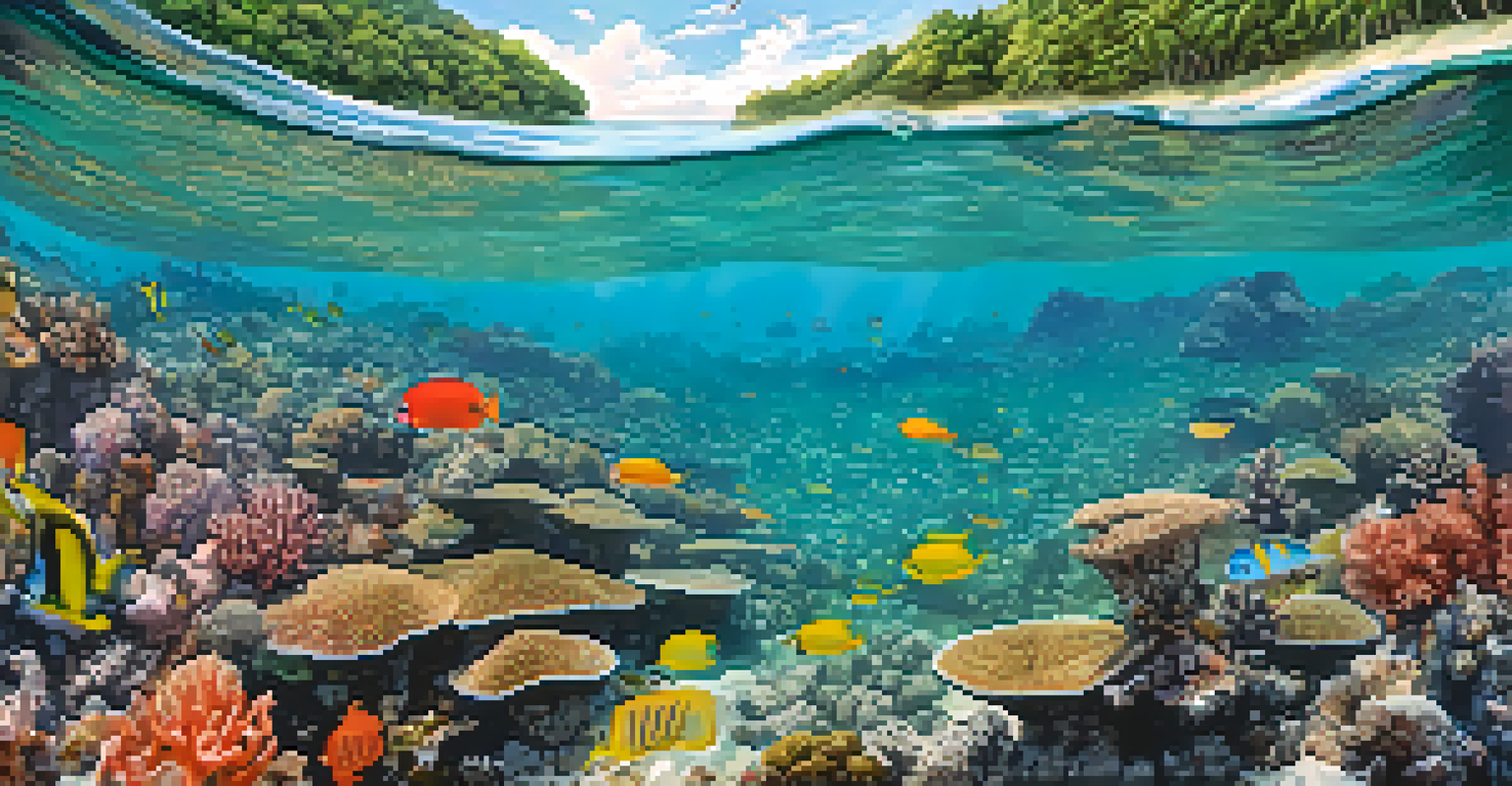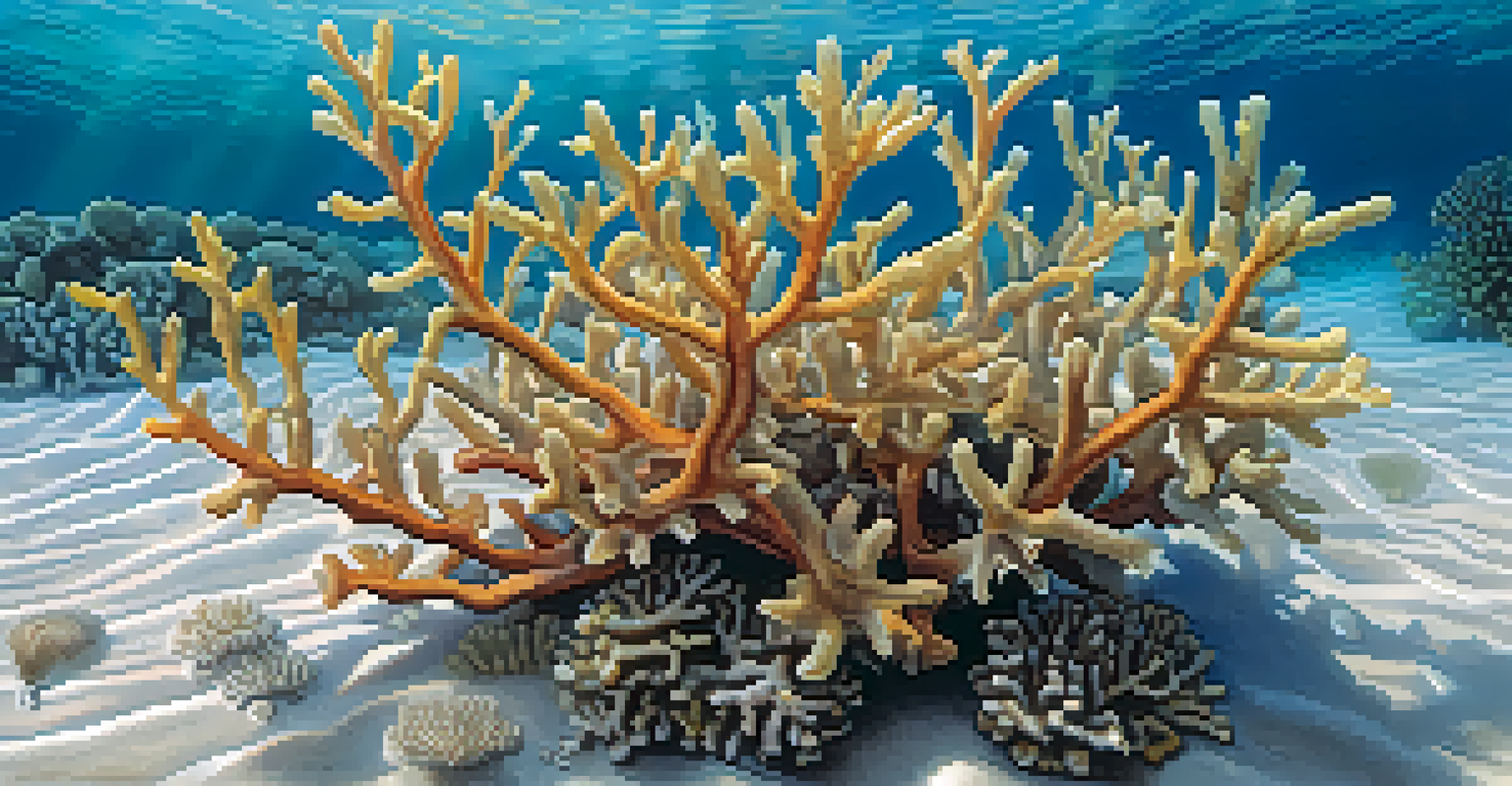Thailand's Marine Life: Coral Reefs and Their Inhabitants

Introduction to Thailand's Marine Biodiversity
Thailand is renowned for its stunning beaches and warm waters, but beneath the surface lies a treasure trove of marine life. The country boasts some of the most vibrant and diverse coral reefs in the world, particularly in areas like the Andaman Sea and the Gulf of Thailand. These underwater ecosystems are not only beautiful but also essential to the health of the ocean.
Coral reefs are the most diverse ecosystems on the planet and are essential to the health of our oceans.
Coral reefs are often called the 'rainforests of the sea' due to their incredible biodiversity. They provide habitat for numerous species, including fish, mollusks, and even sea turtles. As you explore these reefs, you’ll find a complex web of life interacting in fascinating ways, showcasing nature's interconnectedness.
Moreover, Thailand's coral reefs play a crucial role in protecting coastlines from erosion and supporting local economies through tourism and fishing. Understanding this biodiversity is essential to appreciate the balance of marine ecosystems and the need for their conservation.
The Importance of Coral Reefs
Coral reefs are vital for marine ecosystems, serving as nurseries for many fish species. Young fish find shelter among the intricate structures of the coral, which provides protection from predators. This dynamic relationship showcases how essential coral reefs are for maintaining fish populations that many local communities rely on.

In addition to their ecological role, coral reefs contribute significantly to Thailand's economy through tourism. Snorkelers and divers flock to these vibrant reefs to witness their beauty firsthand, generating income for local businesses and fostering a culture of marine conservation. This economic incentive is crucial in efforts to protect these fragile ecosystems.
Coral Reefs: Marine Ecosystem Essentials
Thailand's coral reefs are crucial for biodiversity, providing habitat for marine life and supporting local economies.
However, coral reefs face numerous threats, including climate change, pollution, and overfishing. Understanding their importance not only raises awareness but also encourages collective action to ensure their survival for future generations.
Common Coral Species Found in Thailand
Thailand's coral reefs are home to a variety of coral species, each contributing uniquely to the ecosystem. Hard corals, like brain coral and staghorn coral, form the backbone of the reef structure, while soft corals add a splash of color with their flowing shapes. These different types of corals work together to create a habitat that supports countless marine animals.
The ocean is a central part of our life. It is a connection to each other and to the world. We have to protect it.
The diversity of corals also makes for a stunning underwater landscape. When you dive or snorkel, you'll often see the vibrant colors of the coral contrasting with the blue water, creating a mesmerizing tapestry of life. This visual spectacle is not just beautiful; it plays a vital role in the health of the entire marine ecosystem.
Each coral species has its own unique requirements for growth and survival, making the health of the reef dependent on the delicate balance of its inhabitants. Protecting these coral varieties is essential to maintaining the biodiversity of the reef and the overall health of marine life in Thailand.
Fish Species that Populate Thailand's Coral Reefs
The waters around Thailand's coral reefs are teeming with fish species, making them a paradise for snorkelers and divers. From the colorful clownfish hiding in anemones to the graceful butterflyfish gliding among the coral, the variety is astounding. These fish not only add beauty to the underwater world but also play crucial roles in maintaining the health of the reef.
Many fish species have unique relationships with coral. For example, parrotfish help keep the reef clean by grazing on algae that can otherwise smother corals. This symbiotic relationship demonstrates how interconnected marine life is, as each species contributes to the overall health of the ecosystem.
Threats to Coral Reefs Are Serious
Climate change, pollution, and overfishing pose significant threats to the health and survival of Thailand's coral reefs.
Additionally, the presence of diverse fish species is an indicator of the reef's health. A thriving reef will support a wide range of fish, while a decline in fish populations can signal underlying issues like pollution or habitat degradation. Protecting these fish and their coral homes is essential for preserving the beauty and functionality of Thailand's marine ecosystems.
Threats Facing Coral Reefs in Thailand
Despite their beauty and importance, coral reefs in Thailand are under significant threat from various factors. Climate change is perhaps the most pressing issue, leading to coral bleaching and changes in water temperature that can devastate reefs. This phenomenon occurs when corals expel the algae living in their tissues, turning them white and leaving them vulnerable.
Pollution is another major threat, with runoff from land-based activities introducing harmful chemicals and nutrients into the ocean. This can cause algal blooms that block sunlight and suffocate corals. In addition, overfishing and destructive fishing practices can damage the reef structures and decrease biodiversity, further stressing these fragile ecosystems.
Conservation efforts are crucial to combat these threats. Local communities, governments, and organizations are working together to implement protective measures, from establishing marine protected areas to promoting sustainable fishing practices. Raising awareness about the importance of coral reefs is key to ensuring their survival.
Conservation Efforts for Thailand's Coral Reefs
Recognizing the importance of coral reefs, Thailand has initiated various conservation efforts aimed at protecting these vital ecosystems. Marine protected areas (MPAs) have been established to restrict harmful activities and promote sustainable tourism, allowing reefs a chance to recover and thrive. These areas serve as sanctuaries for marine life, providing a refuge for species that are endangered or threatened.
In addition to MPAs, education and awareness programs are being implemented to inform local communities and tourists about the importance of preserving coral reefs. By fostering a sense of responsibility towards marine environments, these initiatives encourage individuals to engage in eco-friendly practices when interacting with marine life.
Conservation Efforts Are Vital
Initiatives like marine protected areas and community education are essential for safeguarding Thailand's coral reefs for future generations.
Moreover, collaborations with international organizations help to strengthen conservation strategies and share best practices for reef management. These collective efforts are essential to ensure that future generations can continue to enjoy the rich biodiversity of Thailand's coral reefs.
How You Can Help Protect Coral Reefs
As individuals, there are many ways we can contribute to the protection of coral reefs, even if we’re thousands of miles away. First, practicing responsible tourism—such as avoiding touching or stepping on corals while snorkeling—can significantly reduce damage to these delicate ecosystems. Additionally, choosing eco-friendly tours that prioritize conservation can make a big difference.
Another way to help is by supporting organizations dedicated to marine conservation. Donations, volunteering, or participating in beach clean-ups can directly contribute to the health of coral reefs. Every small action counts, and collectively, they can lead to meaningful change.

Lastly, spreading awareness about the importance of coral reefs and the threats they face is crucial. By sharing information with friends and family, we can inspire others to take action and contribute to the ongoing efforts to protect these underwater wonders. Together, we can ensure a healthier ocean for generations to come.